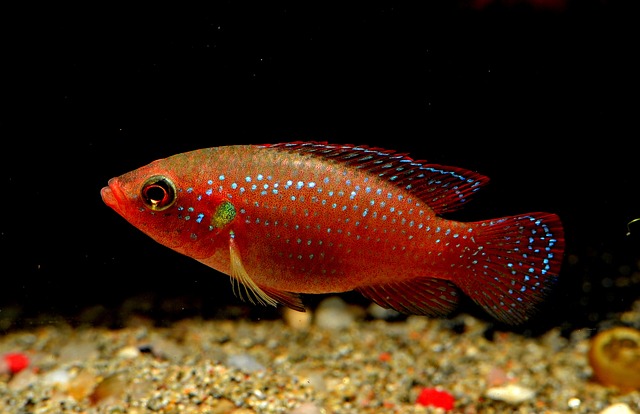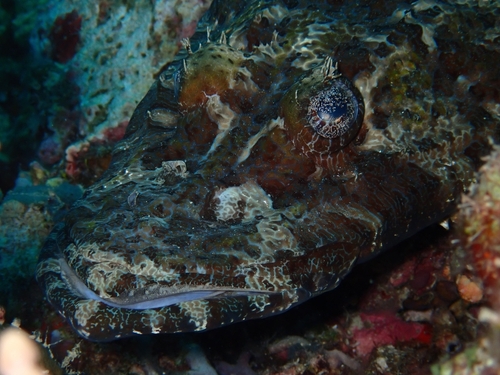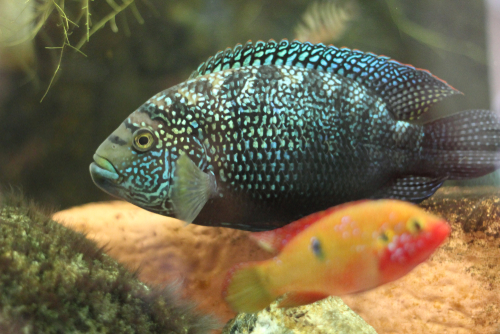Believe it or not, even though there are tens of thousands of different species of fish all over the world, tracking down 75+popular fish that start with J is a bit more challenging than you might think.
That said, there are still some very popular fish – saltwater fish and freshwater fish alike – that have names that start with this letter. And we highlight many of them below!
Contents
Popular Fish That Start with J
More similar posts:
- Popular Fish That Start with Q
- Popular fish that start with U
- Popular Fish That Start With O
- Popular Fish That Start with E
1. Jack
Jack fish makeup a relatively large family of fish found all over the world, including “jacks” as well as jack mackerel, pompano, runners, and scads as well.
Technically considered “ray finned” fish, researchers have found these fish to be incredibly fast underwater and relatively predatory fish that love to hunt the same way that sharks do.
They go out into the open ocean, settle on top of reef structures, and then they work independently to pick off smaller fish at every opportunity.
Decently sized fish, the largest of the jacks – the Greater Amberjack – can grow to be 6.5 feet in length (and sometimes even larger than that).
Some of these fish are hunted specifically for their flash, including by commercial fishers that love to catch as many of these in their nets as possible. The Pacific jack mackerel, for example, is beloved for its meat – not just by commercial fish operations, but by sport anglers as well.
2. Jaguar Catfish
One of the most unique fish in the catfish family – which is a gigantic fish family, to be fair – these fish have unique spots and patches all over their body that make them look like the legendary predatory cat they are named after.
While these fish are carnivorous by nature they are also pretty peaceful and even almost docile creatures. That’s pretty rare in a fish that has to eat other fish to survive – but once these catfish have had their fill they really sort of settled down into a regular, quiet routine.
Folks that want to keep jaguar catfish are able to do so without a whole lot of headache or hassle. Just make sure that the substrate used in a large enclosure (50 gallons at least) is soft, as these fish love to go down to the bottom and spend their time in the sand.
Adding plants is also a good idea. A little bit of cover helps these fish settle down some, but it also gives them space to claim as their own if they are kept in an aquarium with other catfish.
3. Jawfish

The jawfish is a tropical exotic fish with a very unique kind of look, but a perfect fish to add to your saltwater aquarium – even if you have other different types of fish in the aquarium already.
A bit of a “class clown”, these fish have a ton of personality, are about as friendly as can be, and even like to post up in the water column to look out of their enclosure and watch the people around them.
It’s wild to see this happen the first few times, but it really helps you better connect with your jawfish – making them feel like a big part of your family!
Relatively small fish (growing up to about 4 inches in length when fully mature), you don’t necessarily need a ton of water to keep these fish happy and healthy – 30 gallons at a minimum – but you will want to keep water conditions dialed in.
Temperatures of between 72°F and 82°F are ideal, and you also need to make sure that your toxins and oxygen levels are consistent, too.
4. Jewelfish

Thinking about adding a jewel fish to your aquarium?
That’s not a bad idea so long as you are prepared to sort of build your aquarium environment around these fish (adding other fish later down the line that can survive in these kinds of conditions, too).
For starters, these fish need warm water conditions. We are talking about 75°F to 80°F, and sometimes even warmer than that. You want your pH levels between 6.5 and 7.5 (and maintained in that “envelope” consistently). Water hardness should be somewhere between 4 and 16 dGH.
On top of all of that, though, you’ll also want to make sure that you have at least 40 gallons of water for a single jewel fish. Each additional jewel fish will need another 10 gallons – and you want to be sure that you are pairing these fish off ALWAYS.
Add an odd number (except for a solo) and you’ll end up with some pretty nasty territorial battles.
5. Japanese Flathead

Interestingly enough, even though the Japanese Flathead – sometimes called the summer blowfish – has been considered a rare delicacy in Japan for thousands of years, very little is known or understood about this fish in the English-speaking world.
A very thick scaled fish (the scales are so durable, in fact, that they are often removed in restaurants by using steel wool), these fish sort of look like a cross between a catfish and some of the bottom feeding fish species around the world – with a big, flat head (no surprise there) and a long stiff tail.
The traditional way to eat this fish is for it to be served raw over rice, with just a little bit of salt to flavor the tender white flesh. The flavor is rich and decadent (unique for a white fish). The best time to catch and eat these fish is in the late summer.
6. Japanese Rubyfish
Typically found in the West Pacific Ocean, it’s not at all unusual to find the Japanese Ruby fish off the coast of Western Australia and Queensland – though it obviously makes its way up to Japan as well (hence the name).
A bottom dwelling fish that are most frequently found at depths hovering somewhere between 100 m and 400 m, these aren’t the kinds of fish that are caught all that frequently by sport fishermen or even commercial anglers.
That said, a world record Japanese Ruby fish was caught off the coast of Japan about 10 years ago.
This monster weighed in at almost 9 pounds and was captured with a bait of sliced up squid. Interestingly enough, the anglers that caught this world record fish were actually targeting it specifically (remember, these fish love incredibly deep depths that most anglers are targeting) – but they were more than happy to land it all the same!
7. Javelin
Javelin fish (sometimes called lighthouse lizard fish) live at relatively shallow depths, hovering anywhere between 2 m up to 100 m below the surface of the ocean. Almost always found near busy reefs and in tropical climates, these fish are incredibly active and swim in pretty decent sized schools.
The average javelin is only going to grow to be about 4 inches in length, with the current world record hovering around 7.8 inches.
Even though these fish are pretty small they are still beloved by folks in Japan as well as Australia for their flavor. It’s not uncommon for them to be caught fresh and sold salted in markets all throughout this part of the Pacific Ocean.
8. Jewfish

Jewfish sometimes go by the name “Atlantic goliath grouper”, a saltwater fish that is considered to be one of the largest species of all bony fish in the sea.
These big, beautiful fish can be found throughout Northeastern Florida, South into the Gulf of Mexico as well as the Caribbean Sea, and even in stretches of South America all the way down to Brazil, even.
Capable of growing to lengths approaching 8 feet and weighing in at north of 800 pounds, it shouldn’t surprise anyone to learn that these fish were once a huge target for commercial fishing operations.
Because of overfishing, though, the global population of jewfish declined significantly and today these fish are protected. Major conservation efforts are underway to bring these populations back, and are currently enjoying tremendous success.
9. Javan Flounder
A funny looking flounder, these fish are pretty flat, have a large round body, and call the West Pacific Ocean, the Persian Gulf, and the Southern China Sea their home (though they are found in other spots around the world, too).
Unlike other flounder, though, these fish aren’t quite as beloved for their flesh and aren’t super popular with the aquarium keeping community, either.
1o. Japanese Lanternfish
Lanternfish are a relatively small fish found in oceans all over the world, and are called lanternfish because of their natural bioluminescence that is almost permanently “on”.
While these fish don’t grow to be very large (the average lantern fish is usually only going to get to about 5 or 6 inches in length) they are pretty easy to find and study – again because of that bioluminescence!
It certainly doesn’t hurt that these fish also love to swim in shallower waters, giving folks the world over an opportunity to see how they glow (especially after the sun goes down).
65 More Fish Names That Start with J

1. Jensen’s Skate
2. Japanese Sillago
3. Japanese Bigeye
4. Janss’ Pipefish
5. Japanese Rice Fish
6. Japanese Beardfish
7. Jellybean Tetra
8. Jenny Mojarra
9. Japanese Perchlet
10. Japanese Armorhead
11. Japanese Topeshark
12. Javanese Ricefish
13. John Dory
14. Jerdon’s Baril
15. Japanese Flyingfish
16. Japanese Jawfish
17. Java Stingaree
18. Jenynsia Diphyes
19. Japanese Gissu
20. Jae Barb
21. Jenyns’ Sprat
22. Jenynsia Eirmostigma
23. Japanese Gizzard Shad
24. Jamaican Killifish
25. Jamaica Weakfish
26. Japanese Meagre
27. Japanese Halfbeak
28. Jenynsia Alternimaculata
29. Jenynsia Sanctaecatarinae
30. Jenynsia Tucumana
31. Jackson’s Barb
32. Jack Dempsey
33. James’s Anchovy
34. Jenkin’s Scorpionfish
35. Japanese Grenadier Anchovy
36. Jenynsia Weitzmani
37. Japanese Bullhead Shark
38. Jack-Knifefish
39. Japanese Butterfish
40. Japonolycodes Abei
41. Javelin Pipefish
42. Jenynsia Eigenmanni
43. Japanese Spanish Mackerel
44. Jenkins’ Blenny
45. Japanese Snapper
46. Japanese Inflator Filefish
47. Japanese Blacktail Triplefin
48. Jelly Bean Tetra
49. Japanese Eagle Ray
50. Japanease Bullhead Shark
51. Japanese Leatherjacket
52. Javelin Fish
53. Javan Flounder
55. Japanese Goatfish
56. Java Barb
57. Japanese Smelt
58. Jenkins’ Grunter
59. Jeanpol’s Killi
60. Japanese Gray Smooth Hound
61. Japanese Spearfish
62. Japanese Striped Loach
63. Japanese Large-Eye Bream
64. Japanese Lefteye Flounder
65. Japan Surgeonfish

Ian Sterling, founder of Fishlab.com, began his aquarium journey over 30 years ago, driven by a deep fascination for fish and their diverse personalities. His website, Fishlab.com, is dedicated to making fishkeeping accessible and enjoyable, offering beginner-friendly guidance, expert insights, and a community for aquarists to connect and share experiences.


